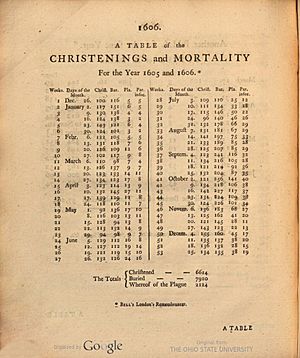John Graunt facts for kids
Quick facts for kids
John Graunt
|
|
|---|---|
| Born | 24 April 1620 London
|
| Died | 18 April 1674 (aged 53) London
|
| Nationality | English |
John Graunt (born April 24, 1620 – died April 18, 1674) was an English businessman. He is often called the founder of demography. This is the study of how human populations change.
Graunt was one of the first people to study populations using numbers. He was also perhaps the first to study epidemiology. This is the study of how diseases spread. Even though he did important scientific work, his main job was being a haberdasher. This means he sold small sewing items. Later in life, he lost his money because of the Great Fire of London. He also faced difficulties after he became a Catholic.
Contents
Who Was John Graunt?
John Graunt was born in London. He was the oldest of seven or eight children. His father, Henry Graunt, was a cloth seller who moved to London. In 1641, John Graunt married Mary Scott. They had one son and three daughters. When he was 21, he became a full member of the Drapers' Company. This was a group for cloth sellers.
Graunt worked in his father's shop until his father passed away in 1662. John Graunt became an important person in the City of London. He even helped his friend William Petty get a job as a music professor in 1650. Graunt also held several local government jobs. He became a councilman and a leader in the Drapers' Company.
How Graunt Studied People and Diseases
John Graunt, along with Sir William Petty, helped create early ways to study human populations using statistics. They developed methods for census taking. A census is a count of all the people in an area. Their work helped create modern demography.
Graunt is famous for making the first life table. This table showed the chances of people surviving to different ages. This was amazing because the old records, called Bills of Mortality, did not list how old people were when they died. Graunt used his math skills to figure this out. He is also seen as one of the first experts in epidemiology. His famous book was mostly about numbers related to public health.
Graunt's Famous Book
Graunt's important book was called Natural and Political Observations Made Upon the Bills of Mortality. He gave 50 copies of his book to the Royal Society of London in 1661. This group was for important scientists. Because of his book, he was chosen to be a member in 1662. King Charles II himself suggested that the Royal Society should accept Graunt. This was special because Graunt was a tradesman, not a rich scholar. Graunt later became a council member of the Royal Society.
What Were the Bills of Mortality?
Graunt's book used and studied information from the Bills of Mortality. These were papers that gave details about births, deaths, and causes of death in London churches. They were printed every week. There was also a yearly report. Graunt said these Bills started in 1592 and were regularly printed from 1603.
Graunt explained how the information for these Bills was collected: "When anyone dies, people called 'Searchers' find out. They check what disease or accident caused the death. Then they tell the Parish-Clerk. Every Tuesday night, he reports all the burials and christenings for that week. On Wednesday, the main report is made and printed. On Thursdays, it is given out to families who pay for it."
Graunt was very careful when looking at this information. He even questioned the "Searchers" who decided the cause of death. He thought many causes of death were not reported correctly.
Graunt's Work on Diseases
Graunt's studies helped him understand more about how many people died from certain diseases. He was unsure about the high number of deaths listed as caused by the plague. He wondered if these deaths were wrongly reported. He thought the people reporting the causes of death might not always be reliable.
Another example of Graunt's work was his study of a sudden rise in deaths from Rickets in 1634. He also looked at "Liver-grown" and "Spleen" as causes of death. He compared how often these causes appeared over different years. Graunt wondered if the rise in rickets deaths was because other causes were being mislabeled. He concluded that rickets was truly at its highest point for the first time.
Later Life and Legacy
Graunt's home was destroyed in the Great Fire of London. He also owned shares in a water company, which caused him financial problems. He eventually lost all his money. One of his daughters became a nun in Belgium. Graunt himself decided to become a Catholic. This was a difficult time in England, as Catholics faced challenges.
John Graunt died at age 53 from jaundice and liver disease. His friend John Aubrey said he was "a pleasant, friendly companion and very welcoming." Aubrey also noted that his death was "missed by all good people who had the happiness to know him."
Graunt's work was one of the first times that numbers were used to describe populations. Some of his tables are the only source of population data for certain periods. This is because many records were lost in the Great Fire of London. After his book was published, France started collecting more detailed population counts.
Sir Liam Donaldson honored Graunt's important work in 2012. This was on the tenth anniversary of the Public Health Observatories. John Graunt is also a character in a 1993 play called The Living. This play is about the bubonic plague in London.
Images for kids
See also
 In Spanish: John Graunt para niños
In Spanish: John Graunt para niños
- Ratio estimator





